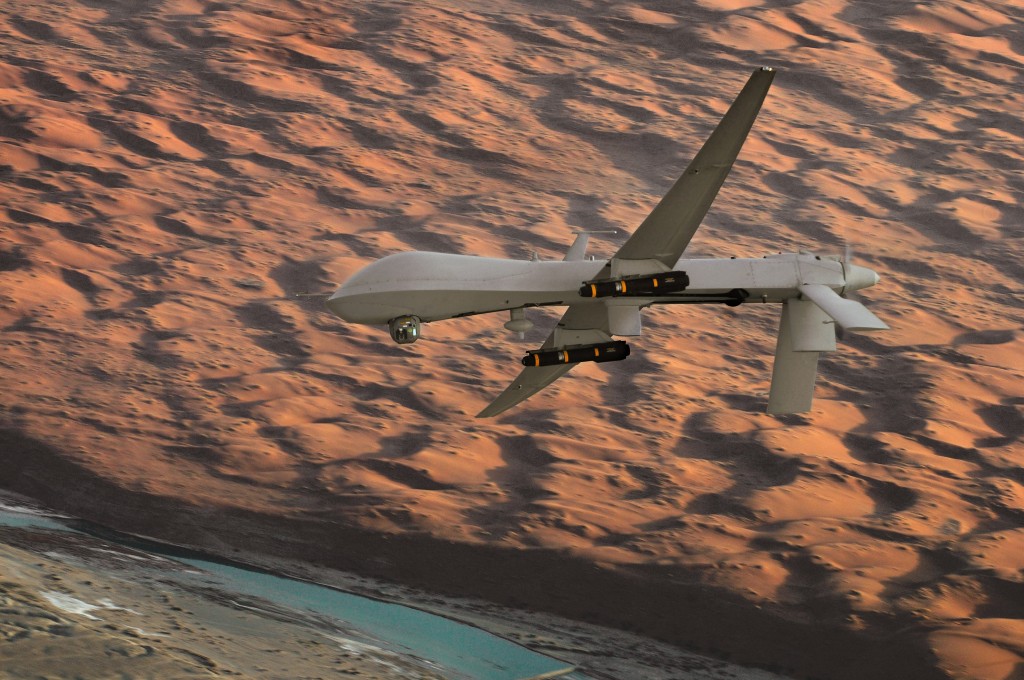Unmanned aerial vehicles (UAVs or drones) are the go-to platform for US targeted killing as part of the ongoing War on Terror. Despite chatter about the possibility of fighter drones operating in contested airspace (a topic taken up recently Malcolm Davis and Peter Layton), it’s in high-value targeting as part of covert counterterrorism operations in unstable and remote regions where UAVs have really shown their worth.
So far the US has made unilateral determinations about the use of armed UAVs. There’s pretty tight control on them—in fact, President Obama himself oversees every target for the covert CIA strikes through what has been labelled the ‘kill list’. While there’s still opposition in some quarters, the world has mostly got used to now routine US operations. But the West mightn’t be as comfortable if other states with armed drones were making similar decisions. While the US has dominated the field (Israel and Great Britain have also conducted limited drone strikes), it’s likely that other powerful states have taken note.
The combination of persistent surveillance and strike capabilities of UAVs such as the US’ Predator and Reaper make them one of the most precise platforms for targeted killing purposes. They also remove the risk of troop casualties and the messiness that comes with boots on the ground. The Long War Journal reports that last year drone strikes killed a senior al Qaeda intelligence chief as well as a key paramilitary commander.
These incentives don’t apply exclusively to the US. In a speech in 2012, CIA Director John Brennan highlighted the drive by many militaries to acquire capabilities to conduct drone strikes. It has been reported that international investment into UAV technology is set to soar, with predictions of it almost doubling in the next decade. A variety of states are pursuing drone technology, which might erode the West’s current dominance.
One of those is China, which has been actively pursuing advanced UAV capabilities. China’s Yi Long drone (aka Pterodactyl), heavily modelled on the US Predator, appears to be one of the People’s Liberation Army’s basic attack UAVs, with the capacity to carry a payload of 200kg. The WJ-600 jet-powered UAV is a faster drone with an even greater 600kg payload and with strike capability. Finally, China has also been developing a stealth combat UAV (called Li Jian or Sharp Sword) that mimics the American X-47B and may eventually launch from aircraft carriers.
The question is, however, in what kinds of situations China might consider using its growing fleet. In late 2011, we were given a rare insight into one possible scenario. A violent drug-lord from Myanmar named Naw Kham had just killed 13 Chinese sailors. In response, Beijing promised to bring the man to justice, beginning a manhunt to locate and capture him inside Myanmar.
After weeks of attempting capture, the Chinese authorities faced a set of calculations that are now familiar to governments like the US. Naw Kham had gone into hiding in a remote and lawless north eastern region of Myanmar, supported by sympathetic locals and protected by over 100 heavily armed subordinates. Attempting capture would risk more lives. It could also potentially embroil authorities in a messy armed stand-off and raise concerns about sovereignty. According to an interview with the leader of the group assigned to capture Naw Kham, the use of an armed UAV to strike his residence was considered as a viable option.
In the end, the Chinese authorities chose not to pursue this tactic and instead managed to capture their man and transport him back to China for trial. A drone strike would have denied Chinese authorities the opportunity of parading him in front of the media and triumphantly handing down the death penalty. In fact, the lead up to Naw Kham’s execution was televised on live TV.
Despite the plan being quashed, the case highlights the possibility that China could turn to the use of armed drones. This episode may be a signpost of the shape of things to come as more militaries acquire UAVs with strike capability; Pakistan, India and Russia all have drone programs that indicate they’re heading toward a fleet of armed drones. It increasingly appears that it’s a question of when – not if – China or someone else will use drone strikes.
On one level, the concern for both the US and Australia will relate to who the Chinese are targeting. A notoriously violent drug-lord hiding within a lawless region is one thing, but China considers as enemies of the state a variety of actors within and outside its borders who may not represent acceptable targets to the West.
Separatist movements in Tibet and Xinjiang are potential examples. Beijing has persistently tried to align the domestic struggle against separatist groups with the US global war on terror to support heavy-handed counterterrorism approaches. The discovery of footage depicting young members of a Xinjiang-based rebel group being trained in North Waziristan, Pakistan last year could provide ammunition to China for justifying drone strikes based on US precedent. What’s more, China’s interests are expanding geographically. There’s a growing presence of Chinese firms and expatriates in resource rich regions of Africa. Threats to Chinese communities or economic interests by militias, gangs or terrorists could represent a scenario in which armed UAVs might be employed as protection or to target those harming Chinese interests.
The US and Australia should be keeping a keen eye on China’s use of drones. As the US has demonstrated, this platform presents many alluring advantages. Just as President Obama appears to be realising, the use of armed drones for targeted killing must be subject to restrictions. But it is increasingly evident that we’ll need to think through what targeted killing might look like in a multipolar world.
Rosalyn Turner is an intern at ASPI. Image credit to Official USAF website.


